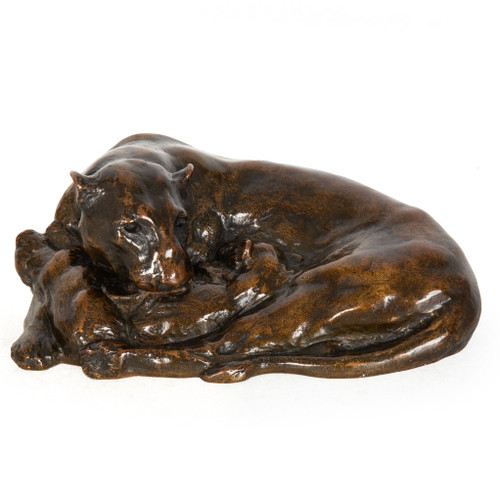catalog text
ANNA VAUGHN HYATT HUNTINGTON
United States, 1876-1973
"Lioness and Cubs"
Sand-cast patinated bronze | signed on the back "Anna V. Hyatt Sc", "4", "Q9", "G [lion] C" (Gorham foundry marking)
Item # 311XBP09D
According to the Gorham Manufacturing Company, Bronze Division records, held in the collection of Brown University's John Hay Library, only 84 casts of Lioness and Cubs were made starting in 1906. However, because the model was included in an exhibition at the at National Arts Club in 1903, we know that it was conceived at least that early. The present cast is a very early edition, as they were numbered progressively and the present cast is number 4, meaning it was likely cast in either 1906 or 1907. Note the extraordinary attention shown to an often forgotten underside of the sculpture, which was unneccessarily cleaned and perhaps even polished by Gorham prior to releasing it. We had an opportunity to carry this model twelve years ago and that example had a plaster filled core and higher in the numerical progression of casts, meaning Gorham and AHH likely decided to save time and no longer make the underside presentation-ready as a cost savings on later casts.
An exceedingly rare cast, first for being of a relatively small line of production but also for its exquisite quality being one of the early casts to have been issued, Lioness with Cubs is an incredibly sensitive image that captures the softer side of this powerful beast and her young.
ANNA VAUGHN HYATT HUNTINGTON
One of the most important American female sculptors of the 20th century, Anna Vaughn Hyatt Huntington would become best known for her animalier sculpture. Born in Cambridge, Massachusetts in March of 1876, she was first influenced by the work of her father as a professor of paleontology and zoology at both the Massachusetts Institute of Technology and the Boston University.
Her sister Harriet, eight years her senior, studied sculpture under Henry Hudson Kitson in Boston and Anna studied under him briefly in 1898, though her formal training was rather limited and she relied instead on a keen understanding of animals together with powerful observation skills. The sisters exhibited their first joint effort together at the National Sculpture Society of New York in 1898.
After her sister married, she began working on her own and had one of her earliest exhibitions in 1902, a one-woman exhibition at the Boston Art Club where she included twenty-five works executed in clay, bronze and plaster. The same year she enrolled at the Art Student's League in New York where she studied modeling under Hermon Atkins MacNeil and drawing with George Grey Barnard.
Hyatt's first important foundry association was with Roman Bronze Works after initially moving to New York, but in 1905 she began working with Gorham Company Founders in Providence, a relationship that would last throughout most of her career. She continued to work with Roman Bronze Works, Kunst Founders, John Williams, Inc and Modern Art Foundry, but the majority of her sculptures were cast by Gorham and she relied on them to market her bronzes from at their Fifth Avenue gallery on a royalty basis.
She was made a Chevalier of the Legion d'Honneur in recognition of her powerful equestrian group Joan of Arc; this was exhibited at the Paris Salon in 1910 as a life-size plaster and in 1914 was commissioned as a larger-than-life-size statue for Riverside Park in New York City. She was further awarded the Purple Rosette by the French government.
In 1923 she married philanthropist and scholar Archer Milton Huntington and together they purchased the 10,000 acre Brookgreen Gardens near Charleston, South Carolina in 1930. While this was first selected as a quiet space to recover after contracting tuberculosis in 1927, the gardens eventually became an important public space showcasing over four-hundred sculptures.
In 1939 they purchased a 1,000 acre compound in Redding Ridge, Connecticut and Huntington began experimenting with aluminum in her sculpture. Her preference for aluminum expanded due to the vibrant surface quality, its natural resistance to oxidization allowing it to be most suitable for outdoor display, its light weight making transportation easier for exhibitions, the lower cost of the material and the freedom the medium would afford to create "open, dynamic compositions that could be supported on narrow points of contact on a base" (Conner & Rosenkranz). The fifteen sculptures she contributed to the traveling exhibition Messengers of Friendship to the Mediterranean in the mid-1950s was entirely executed in aluminum.
She died in her home at the age of ninety-seven on October 4th of 1973. Today her work remains preserved in the permanent collections of over 200 museums.
Artist Listings & Bibliography:
- Anna Hyatt Huntington and Her Big Cats, Daria Rose Foner (http://annahyatthuntington.weebly.com/anna-hyatt-huntington-and-her-big-cats.html)
- Rediscoveries in American Sculpture, Conner and Rosenkranz
- A Century of American Sculpture: The Roman Bronze Works Foundry, Rosenfeld, p. 113
Measurements: 5 7/8" W x 4" D x 2 1/4" H
Condition Report:
Exquisite original condition. Minor rubbing to patina, otherwise no observed flaws.















